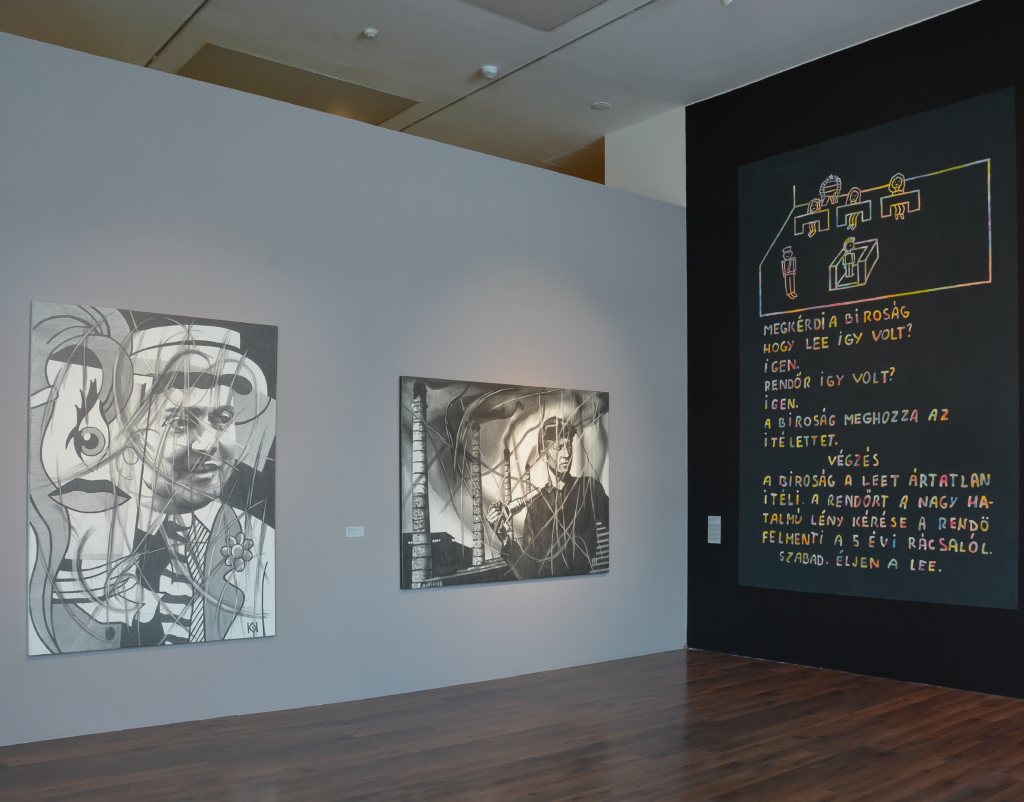Freehand. Drawing in Hungarian fine art yesterday and today
2014. Mar. 02. - 2014. Jun. 29.

Until the twentieth century, drawing lived in the public consciousness as a subordinate complement to other artistic disciplines. It was associated with the broad concept of printmaking, which included all works on paper, including individual drawings, reproductions and applied graphics. From the beginnings of modern Hungarian art, MODEM’s exhibition presents the trends, most exciting experiments and achievements of the unique artistic drawing after 1945 through the works of more than 50 artists who have played and continue to play a role in the current rise of artistic drawing, from Lajos Gulácsy to Imre Bukta and Gruppo Tökmag.
In our country, the drawings of István Nagy, Lajos Vajda, Imre Ámos, Jenő Barcsay, Béla Kondor have a kind of undefined intellectual heritage. Exploring the roots of the Hungarian tradition of this nowadays so important artistic medium, Freehand presents, among others, an emblematic piece of Lajos Vajda’s organic charcoal drawing series of 1940, and several sheets of Jenő Barcsay’s anatomy series, together with the artist’s works from the early 1950s, showing the changing role of drawing in the 20th century and the stages of its development as an independent artistic discipline. One of the leading figures of the Hungarian avant-garde, Béla Uitz, known for his robust imagery, is also represented with a series of study drawings of sensitive subtlety. The selected classic examples create a dialogue with the work of contemporary artists who are interpreting the genre with increasing freedom.
The tradition of drawing is carried on by Imre Bukta’s line-sketched structure from 1977, but also includes works by Attila Kovács, Imre Bak Bak, Dóra Maurer, György Galántai, Károly Kelemen, Péter Kovács and Sándor Pinczehelyi. The exhibition offers an insight into the experimental works of contemporary Hungarian drawing that explore the frontiers of the medium, and pays great attention to the versatile and varied use of the medium. Ádám Albert’s vision box, built after digital preparations, Zsolt Asztalos’ microscopic portraits and Júlia Vécsei’s video animation based on manual phases of graphite powder are as much a part of contemporary drawing as Laura Somogyi’s spatial drawings made of thread-thin wire, Zsolt Tibor’s installation ending in a wall drawing or László Győrffy’s occasional scribbles, collected since 1994 and enclosed in a hut.
Several site-specific works will be created exclusively for the MODEM exhibition: Gruppo Tökmag (Tamás Budha Kovács and András Tábori) will draw graffiti on the wall; Róbert Németh’s monumental drawing box with UV light will completely transform the white-walled room; while Zsófia Szemző will take over the glass entrance to the exhibition space, and the audience can continue the drawing she started. Fans of traditional drawing techniques will be able to see the pencil drawings of Pál Gerber from his various artistic periods, the large charcoal drawings of Attila Szűcs or the delicate pen drawings of István Nyári, reminiscent of a postcard. Several video works can also be seen in the exhibition space, including one of László Csáki’s latest chalk animation films. The curators of the exhibition (Tibor Kocsis and Krisztián Kukla) do not guide the visitors through the exhibition chronologically, but the works on display, in their uniqueness and in dialogue with each other, draw the audience’s attention to the subtleties, sensitivity and intellectual depth of the drawing.
Curators: Iski Kocsis Tibor, Kukla Krisztián
Artists: Ádám Zoltán, Albert Ádám, Ámos Imre, Anna Margit, Asztalos Zsolt, Babinszky Csilla, Bak Imre, Barcsay Jenő, Bukta Imre, Chilf Mária, Csáki László, El-Hassan Róza, Faa Balázs, Galántai György, Gerber Pál, Gruppo Tökmag (Kovács Budha Tamás, Tábori András), Gulácsy Lajos, Győrffy László, Hámori Anett, iski Kocsis Tibor, Kelemen Károly, Keserü Károly, Király András, Kondor Attila, Kondor Béla, Kovács Attila, Kovács Péter, Kupcsik Adrián, Lakner László, Maurer Dóra, Mécs Miklós, Mednyánszky László, Nagy Balogh János, Nagy István, Navratil Judit, Nemes Csaba, Németh Róbert, Nyári István, Pinczehelyi Sándor, Somogyi Laura, Szemző Zsófia, Szíj Kamilla, Szörényi Beatrix, Szűcs Attila, Tibor Zsolt, Tihanyi Lajos, Tót Endre, Tóth Menyhért, Uitz Béla, Agnes von Uray (Szépfalvi Ágnes), Vajda Lajos, Varga Ferenc, Vécsei Júlia, Vojnich Erzsébet, Wahorn András

